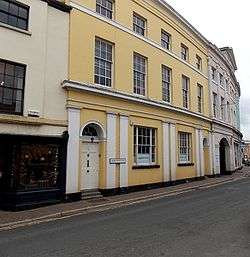1–6 Priory Street, Monmouth
| 1–6 Priory Street | |
|---|---|
 1–6 Priory Street, from No.6 | |
| Type | Shops / Houses |
| Location | Monmouth, Monmouthshire |
| Coordinates | 51°48′46″N 2°42′55″W / 51.8127°N 2.7153°WCoordinates: 51°48′46″N 2°42′55″W / 51.8127°N 2.7153°W |
| Built | c. 1837 |
| Architect | George Vaughan Maddox |
| Architectural style(s) | Neoclassical |
| Governing body | Privately owned |
Listed Building – Grade II* | |
| Official name: 1, 2, 3, 4, 5 & 6 Priory Street | |
| Designated | 10 August 2005 |
| Reference no. | 2320, 85057, 85096, 85123, 85135 & 85148 |
 Location of 1–6 Priory Street in Monmouthshire | |
1–6 Priory Street in Monmouth, Wales, is a row of six shop houses designed by the architect George Vaughan Maddox and constructed c. 1837. They form part of Maddox's redevelopment of the centre of Monmouth and stand opposite his Market Hall. The architectural historian John Newman has written that Maddox's work "gives Monmouth its particular architectural flavour," and considers Priory Street to be "his greatest work."
History
In the early 19th century, the main thoroughfare out of Monmouth towards London was Church Street,[1] a relatively narrow street now pedestrianised. Increasing traffic on the street led to a number of accidents and demands for the construction of a new road.[2] At the same time, developments at the Shire Hall in Agincourt Square meant that the market, previously located there, required new accommodation.[3] In 1834, the Town Council offered a prize for a redevelopment scheme, which was won by George Vaughan Maddox.[2] Maddox, the son of another Monmouthshire architect, John Maddox, had already established a reputation within the town.[4] Maddox's proposals envisaged a new road, described by John Newman as "a remarkably early inner bypass",[5] that would run north of Church Street along the west bank of the River Monnow. Above the embankment side would stand slaughterhouses, supporting the new Market Hall, and facing the Hall, a row of grand residential houses, backing on to Swan Court.[2] The road was called Priory Street, as its course ran next to Monmouth Priory on the route from the centre of the town.
Architecture and description
Numbers 1–6 Priory Street form a curved, symmetrical frontage at the beginning of Priory Street as it runs north-east from Agincourt Square.[6] The whole block is of three storeys and nineteen bays.[7] The frontage is stuccoed, and decorated with pilasters,[7] typical of Maddox's "good facades."[4] The roofline has a central attic, under a pediment and lit by a shallow window.[7]
The composite grouping has been designated a Grade II* listed building for "its exceptional architectural interest as part of an important piece of early 19th century town planning."[8]
Notes
- ↑ Heath 1804, p. unnumbered.
- 1 2 3 Kissack 1975, p. 299.
- ↑ Kissack 1975, p. 298.
- 1 2 Kissack 2003, p. 35.
- ↑ Newman 2000, p. 394.
- ↑ "Listed Buildings – Full Report". Cadw. 27 June 1952. Retrieved 1 April 2017.
- 1 2 3 Newman 2000, p. 406.
- ↑ BLBO. "Nos.1,2,3,4,5 & 6 Priory Street, Monmouth". Britishlistedbuildings.co.uk. Retrieved 1 April 2017.
Sources
- Heath, Charles (1804). Historical and descriptive accounts of the ancient and present state of the town of Monmouth. Monmouth: Charles Heath. OCLC 18491234.
- Kissack, Keith (1975). Monmouth: The Making Of A County Town. Chichester: Phillimore. ISBN 0-85033-209-5.
- Kissack, Keith (2003). Monmouth and its Buildings. Woonton Almeley: Logaston Press. ISBN 1-904396-01-1.
- Newman, John (2000). Gwent/Monmouthshire. The Buildings of Wales. London: Penguin. ISBN 0-14-071053-1.